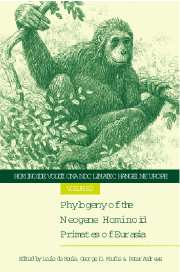 Hominoid Evolution and Climatic Change in Europe
Hominoid Evolution and Climatic Change in Europe Book contents
- Frontmatter
- Contents
- List of Contributors
- Acknowledgements: The European Science Foundation
- PART I: Chronology and environment
- PART II: Methods and phylogeny
- PART III Miocone hominoids: function and phylogeny
- 8 Eurasian hominoid evolution in the light of recent Dryopithecus findings
- 9 Functional morphology of Ankarapithecus meteai
- 10 African and Eurasian Miocene hominoids and the origins of the Hominidae
- 11 Phylogenetic relationships of Ouranopithecus macedoniensis (Mammalia, Primates, Hominoidea, Hominidae) of the late Miocene deposits of Central Macedonia (Greece)
- 12 Phylogeny and sexually dimorphic characters: Canine reduction in Ouranopithecus
- 13 Heterochrony and the cranial anatomy of Oreopithecus: some cladistic fallacies and the significance of developmental constraints in phylogenetic analysis
- 14 The late Miocene hominoid from Georgia
- 15 Forelimb function, bone curvature and phylogeny of Sivapithecus
- 16 Sivapithecus and hominoid evolution: some brief comments
- Index
16 - Sivapithecus and hominoid evolution: some brief comments
from PART III - Miocone hominoids: function and phylogeny
Published online by Cambridge University Press: 06 January 2010
- Frontmatter
- Contents
- List of Contributors
- Acknowledgements: The European Science Foundation
- PART I: Chronology and environment
- PART II: Methods and phylogeny
- PART III Miocone hominoids: function and phylogeny
- 8 Eurasian hominoid evolution in the light of recent Dryopithecus findings
- 9 Functional morphology of Ankarapithecus meteai
- 10 African and Eurasian Miocene hominoids and the origins of the Hominidae
- 11 Phylogenetic relationships of Ouranopithecus macedoniensis (Mammalia, Primates, Hominoidea, Hominidae) of the late Miocene deposits of Central Macedonia (Greece)
- 12 Phylogeny and sexually dimorphic characters: Canine reduction in Ouranopithecus
- 13 Heterochrony and the cranial anatomy of Oreopithecus: some cladistic fallacies and the significance of developmental constraints in phylogenetic analysis
- 14 The late Miocene hominoid from Georgia
- 15 Forelimb function, bone curvature and phylogeny of Sivapithecus
- 16 Sivapithecus and hominoid evolution: some brief comments
- Index
Summary
Introduction
‘I cannot but recall that the Miocene hominoid fossil record seemed a lot less confusing before the discovery of two Sivapithecus humeri…’
(Larson, 1998: p. 97)We address here, briefly, a particular problem, the relationship of Sivapithecus and Pongo, but we also review some more general issues involving Miocene apes and the phylogenetic analyses of fossils. As is not well known, certain features suggest a specific Sivapithecus–orang-utan link (Pilbeam, 1982; Ward & Kimbel, 1983; Ward & Brown, 1986; Moyà-Solà & Köhler, 1995; Begun & Kordos, 1997), for example: frontal bone shape and internal architecture; orbital shape and interorbital distance; facial profile; and (especially) palatal– premaxillary morphology. But as is also now well known, other features – postcranial, facial, mandibular and dental – either do not show such similarities, or fail to show similarities to any living apes large or small (Corruccini, 1975; Corruccini & McHenry, 1980; Ward & Brown, 1986; Pilbeam et al., 1990; Rose, 1997; Uchida, 1998).
Clearly there are very interesting patterns of homoplasy involving either facial, dental or postcranial regions, or all of the above. One immediate question concerns the region in which homoplasy is most likely to occur – postcranial, cranial, or dental? We detect something of a tendency to point the finger at the postcranium (Begun, 1993; Moyà-Solà & Köhler, 1996; Ward, 1997; Richmond, 1999). The ‘Sivapithecus dilemma’ has served as a trigger for a series of recent analyses of living hominoid postcranial morphology addressing the extent to which crown hominoid postcranial similarities are homoplasies. Thus Begun (1993) and Larson (1998) have argued that some of the postcranial characters traditionally used to define the living hominoids are likely to be homoplasies (either convergences or parallelisms).
- Type
- Chapter
- Information
- Hominoid Evolution and Climatic Change in EuropePhylogeny of the Neogene Hominoid Primates of Eurasia, pp. 349 - 364Publisher: Cambridge University PressPrint publication year: 2001
- 14
- Cited by


